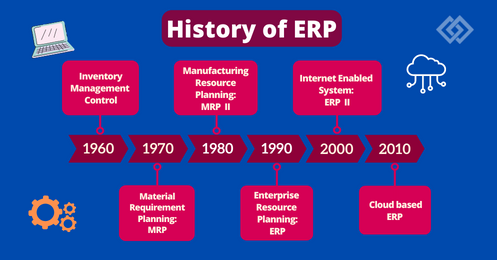Guest Post by: Akshat Akarsh (Ash)
An Enterprise Resource Planning (ERP) system is the key to integrating critical business functions across an organization. ERP systems are expansive pieces of software with a wide variety of functions and applications available to their users. The growth of ERP systems over the past couple decades proves the competitive advantage it can give to a successful business.
ERP started as a way to expand the coordination of different manufacturing undertakings under one enterprise and later evolved to include more back-end professionals. ERP systems have been around for about 60 years, but there have been several changes and many names for ERP systems over time. Let’s take a look at the evolution of the software.
Brief History of ERP
ERP systems date back to the 1960s; however, they’ve only become understood in their current form in the past few decades. Having started off as material requirements planning (MRP) systems in 1960, Enterprise Resource Planning, has come a long way.
1960s-1970s - The first MRP system emerged from a collaboration between IBM and a manufacturer of tractors and construction machinery: J.I Case. Early MRP systems enabled businesses to track inventory and production, though they were expensive to create, required a team of experts to maintain, and took up a lot of space because the solution required to be On-Premises. MRP helped manufacturers monitor inventory, and reconcile balances, as well as included very basic manufacturing, purchasing, and delivery functions. The technology remained limited to large companies that had the budgets and resources for in-house development. Through the 1970s more and more manufacturers started to adopt MRP systems, and the systems themselves got more sophisticated.
1980s-1990s - MRP systems evolved into what became known as MRP II or Manufacturing Resource Planning. More sophisticated solutions were added to the original MRP software and it supported manufacturing processes beyond inventory and raw materials procurement. These MRP II systems had expanded capabilities and were better able to handle scheduling and production processes.
1990s-2000s - For the first time in the 1990s, The Gartner Group used the term ERP and the term ‘ERP’: Enterprise Resource Planning was coined. The new system expanded to include other departments and functions, such as accounting, finance, and sales, beyond the basic inventory control and manufacturing processes of previous iterations. These systems integrated multiple processes and departments into one system. ERP uses a multi-module application software system for improving the performance of the internal business processes.
2000s-2010s – In 2000, Gartner introduced the idea of ERP II as internet-enabled software that gave real-time access to the ERP solution. It provided more functions beyond the core front-to-back integration, like customer relationship management (CRM), business intelligence, e-commerce, supply chain management (SCM), and human capital management (HCM). This was a significant advance because the more information that feeds into the ERP system, the better users are able to react to changes in demand or new trends in their industry and resolve issues and capitalize on opportunities for improvement.
2010 – Present-day - Since the advent of sophisticated technologies and data storage, it has given rise to cloud-based ERP, which has grown in popularity in recent years. Business applications that are delivered as a Software as a Service (SaaS) model means companies no longer need to purchase and maintain hardware, reducing the need for IT staffers and leading to easier implementations. This is seen as an improvement over On-Premises systems, as businesses can access data through the web from any device with an internet connection.
Cloud vs On-Premises
One of the biggest differences between On-Premises software and cloud-based software is cost. On-Premises systems refer to software that you manage on your equipment which means that the business is responsible for purchasing the server equipment and hardware, then configuring the server to run the software and programs. This also includes the management of security, back-ups, and data privacy.
Cloud ERP systems provide comparable functionalities at a much lower cost, especially those using the public cloud model as the costs could be divided among multi-tenant users. In SaaS models, the servers are deployed on the cloud which is designed so that users connect over the internet and pay an ongoing fee to use the system. This made ERP solutions available to small and midsize businesses that lacked the capital to launch and support a resource-intensive on-premises solution. They could now enjoy the same benefits as their larger counterparts, like automated processes, improved data accuracy, and greater efficiency. With cloud software, the software vendor is responsible for managing the physical hardware and servers.
The Future of ERP systems
New developments happen every year that make the future of ERP Trends more dynamic. The future seems promising for the ERP software users with the integration of machine learning (ML) and artificial intelligence (AI). The technology will continue to lean towards the Internet of Things(IoT) which will probably shape up the future of ERP systems as these intelligent ERP systems (iERP) can make use of advanced data analytics in order to lend incredible predictive power to business operations and reduce manual tasks to maximize output with minimum effort. In short, ML and AI will empower businesses to make rapid adjustments that would drive success.
The spread of IoT devices like sensors, cameras, tracking systems, and scanners has also had an impact on recent ERP businesses. By connecting production and distribution devices directly to the central database provided by ERP systems IoT has started to carve out a place among manufacturers and distributors because it helps businesses assemble a comprehensive, real-time picture of their supply chains.
The advancement in technology has always accompanied the history of ERP and it will continue to boost business growth.










